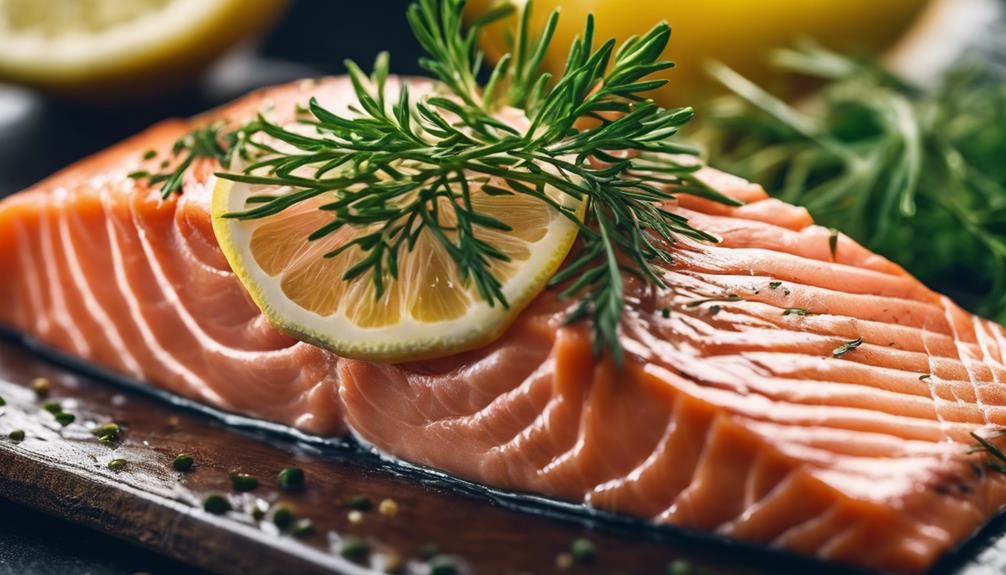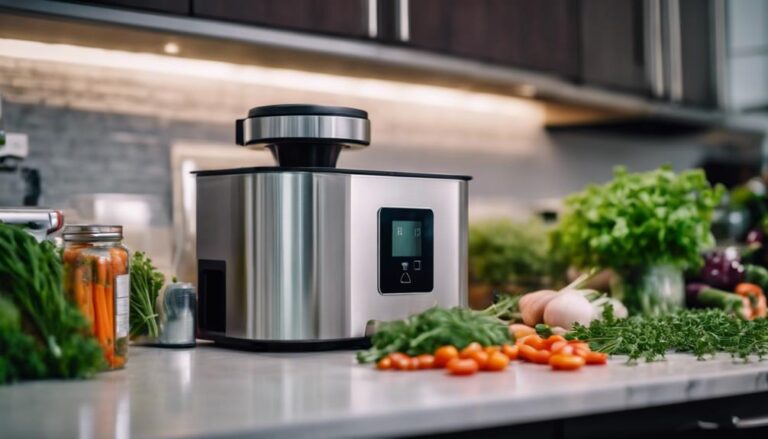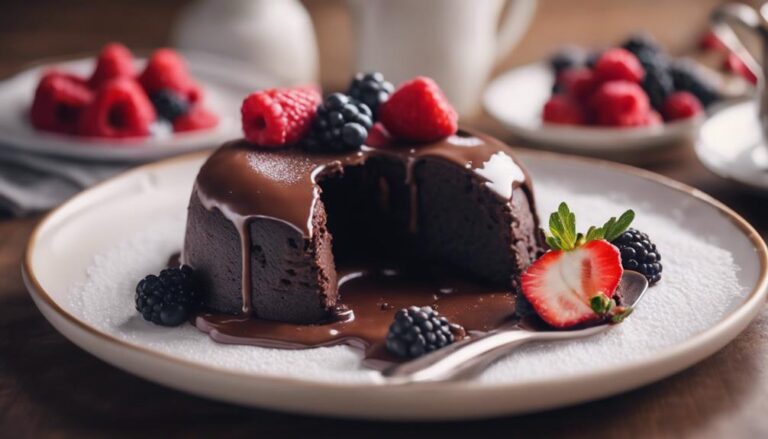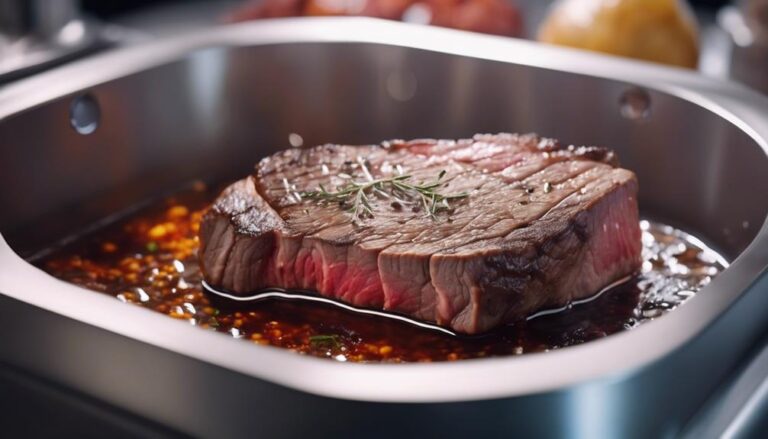Mastering Sous Vide Seafood Cooking Techniques
Mastering sous vide seafood cooking techniques elevates your skills. Cook at precise temperatures for perfect doneness, enhancing delicate flavors and textures. Choose fresh, sustainably sourced seafood for best results. Brine, season, and chill seafood before sous vide cooking. Follow recommended temperatures for safety and quality. Use food-grade bags to maintain standards. Try recipes like Sous Vide Lobster Tail, Salmon with Dill Sauce, and Scallops with Lemon Herb Butter. Elevate your dishes to new levels with these techniques.
What You Will Learn Here
- Precise temperature control ensures perfect doneness without overcooking delicate seafood like sea bass.
- Brine seafood to enhance texture and flavor before sous vide cooking.
- Properly season seafood with salt, oil, and herbs in sous vide pouches for optimal taste.
- Chill cooked seafood in ice water post-cooking to maintain freshness and texture.
- Use food-grade bags for sous vide cooking to ensure food safety and prevent contamination.
Sous Vide Seafood Basics
When preparing seafood using the sous vide method, it's essential to understand the fundamental principles that underlie this cooking technique. Sous vide cooking involves sealing sea bass or other seafood in pouches and cooking them in a water bath at precise temperatures. This method allows you to retain the natural flavors, juices, and textures of the sea bass, ensuring a succulent and perfectly cooked dish every time.
One of the key advantages of cooking sea bass sous vide is the precise temperature control it offers. By cooking the fish at a constant and specific temperature, you can achieve consistent and best doneness without the risk of overcooking. This is particularly important when working with delicate seafood like sea bass, where maintaining the perfect texture is essential for a delightful dining experience.
Mastering the sous vide method for cooking seafood allows you to enhance flavors through seasoning and finishing techniques, ensuring that each bite is bursting with freshness and taste.
Choosing the Right Seafood
When selecting seafood for sous vide cooking, prioritize fresh options with firm textures and mild flavors to enhance your dish.
Guarantee the seafood is sustainably sourced and contemplate the thickness for precise cooking times.
Experiment with a variety of seafood types to explore the full potential of sous vide techniques.
Fresh Vs. Frozen
Choosing between fresh and frozen seafood for your sous vide cooking can greatly impact the quality and flavor of your dish.
Fresh seafood is known for its top-notch quality and flavor since it's processed and sold quickly. On the other hand, frozen seafood preserves freshness and nutrients immediately after harvesting through rapid freezing techniques.
Both fresh and frozen seafood are suitable for sous vide cooking, but factors like storage conditions and handling practices play a vital role in maintaining quality. Fresh seafood offers seasonal and locally sourced options, whereas frozen seafood provides convenience and extended shelf life.
Whether you choose fresh or frozen, ensuring proper storage and handling will help you achieve excellent results in your sous vide seafood dishes.
Sustainable Sourcing
For ideal environmental impact and ethical considerations in your sous vide seafood cooking, prioritize sourcing fish species that are sustainably harvested and certified by organizations like MSC or ASC. When choosing seafood for your sous vide dishes, consider the following:
- Seafood Certifications: Look for labels like MSC or ASC to guarantee responsible sourcing practices.
- Fishing Methods: Opt for line-caught or pole-caught seafood, as these methods are generally more sustainable than trawling.
- Seasonality: Be mindful of the time of year when certain species are more abundant and fresher, promoting sustainable sourcing practices.
Preparing Seafood for Sous Vide
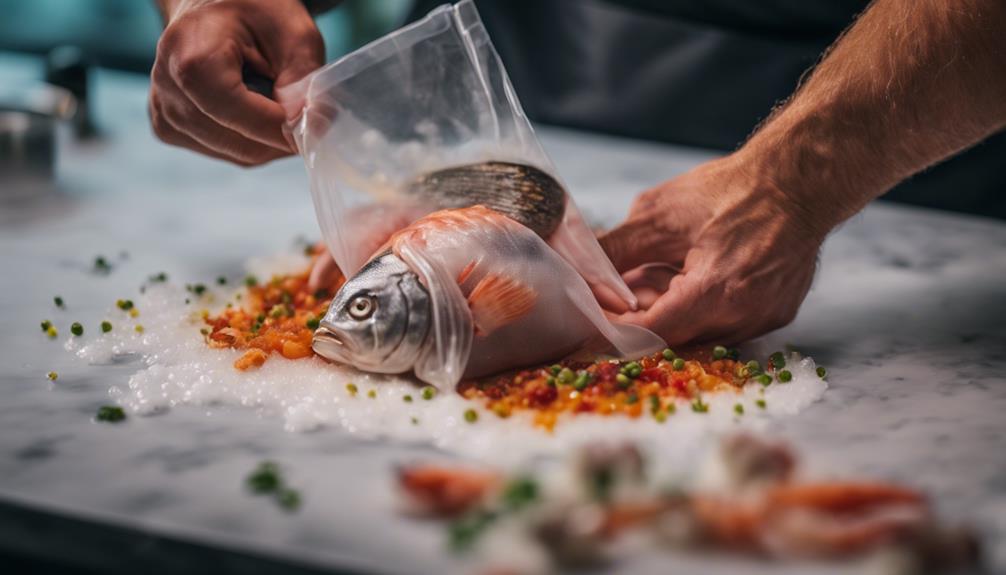
When getting ready to sous vide seafood, remember to brine it first to enhance texture.
Pre-portioning your fish will help it stay intact throughout the cooking process.
Don't forget to season the fish before placing it in the sous vide pouch for a burst of flavor.
Sous Vide Seafood Prep
To enhance the flavor and texture of your seafood when preparing it for sous vide cooking, make sure you season it properly with salt, oil, and herbs before vacuum sealing. Here are some essential tips for sous vide seafood prep:
- Proper Seasoning: Guarantee your seafood is well-seasoned with a blend of salt, oil, and herbs to improve its taste profile.
- Pre-Portioning: Pre-divide your seafood into individual portions before sealing in a sous vide pouch to prevent delicate pieces from breaking apart.
- Chilling: After sous vide cooking, chill your seafood in ice water to maintain freshness and prevent breakage.
Ideal Vacuum Sealing
Consider using high-quality vacuum-sealed plastic pouches when preparing seafood for sous vide cooking to ensure ideal airtight conditions for precise culinary results. Vacuum sealing is essential as it prevents water from entering the pouch and affecting the cooking process.
Seal each piece of seafood individually in pouches to preserve distinct flavors during cooking. This method not only maintains the integrity of the ingredients but also enhances the overall flavor, texture, and juiciness of your sous vide seafood dishes.
Seasoning Tips
Enhancing seafood flavors through strategic seasoning is a vital step in preparing for sous vide cooking. To guarantee your seafood dishes are bursting with delicious flavors, follow these seasoning tips:
- Season before sealing: Season your seafood with salt, oil, and herbs before placing it in the sous vide pouch to enhance flavors.
- Use herbs wisely: Herbs should be used sparingly since flavors are locked in the pouch during sous vide cooking.
- Pre-portion seafood: Pre-portion your seafood before sous vide cooking to ensure even seasoning and cooking throughout.
Lightly seasoning with salt, oil, and herbs can greatly enhance the natural flavors of seafood during the sous vide process.
Seasoning and Flavoring Techniques
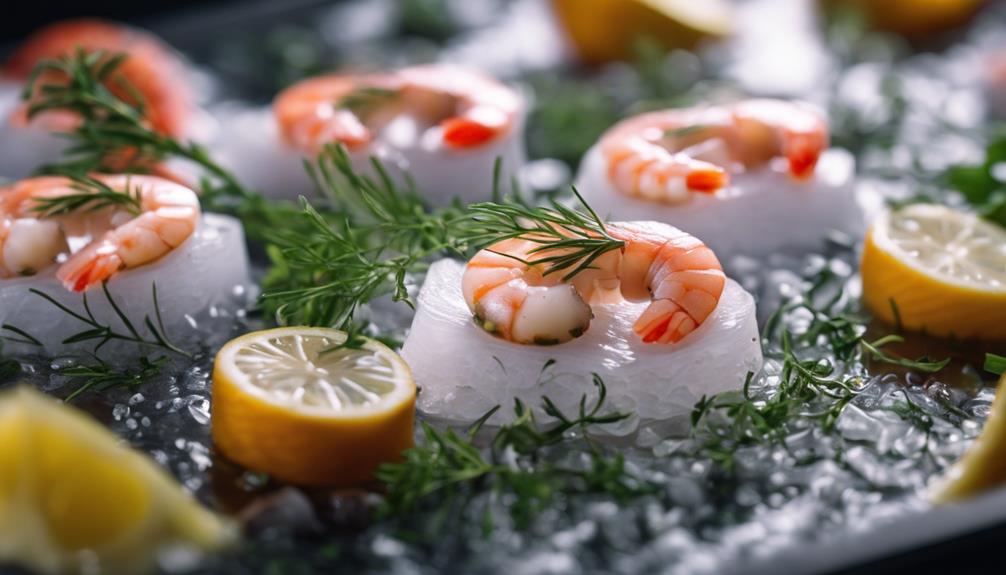
Before placing your seafood in the sous vide pouch, season it with a combination of salt, oil, and herbs to boost flavor absorption and guarantee consistent taste throughout the cooking process. By seasoning your fish before sous vide cooking, you enable the flavors to infuse and permeate the meat, resulting in a more flavorful dish. Remember to use salt, oil, and herbs sparingly, as the enclosed environment of the pouch prevents flavors from escaping during cooking.
For an extra touch of richness and flavor, consider adding a teaspoon of butter along with your favorite herbs to each fillet before sealing it in the sous vide pouch. This addition can elevate the taste profile of your seafood dish and create a more indulgent dining experience.
Seasoning your fish with salt and oil before placing it in the sous vide pouch not only enhances the texture but also guarantees that the flavors are evenly distributed, providing a consistently delicious outcome every time you cook seafood using this method.
Sous Vide Cooking Temperatures and Times
To achieve the best results when cooking seafood sous vide, it's essential to understand the recommended temperatures and cooking times for different types of fish. Here are some key points to keep in mind:
- Temperature Variations: Oil-rich fish such as salmon, tuna, and mahi-mahi are best cooked sous vide at temperatures ranging from 135℉ to 143℉. On the other hand, white, lean, and firm fish varieties like cod, halibut, and swordfish require precise sous vide temperatures to retain tenderness.
- Enhancing Flavor: For white, lean, and flaky fish like black sea bass and red snapper, consider adding butter and herbs per fillet before sous vide cooking. This step enhances the flavor profile of the fish, making it even more delicious.
- Optimal Doneness: Different sous vide cooking temperatures are crucial for achieving optimal doneness in various fish types. Sous vide cooking allows for precise control over cooking times and temperatures, ensuring consistent and perfect results every time you cook seafood sous vide.
Finishing and Serving Seafood
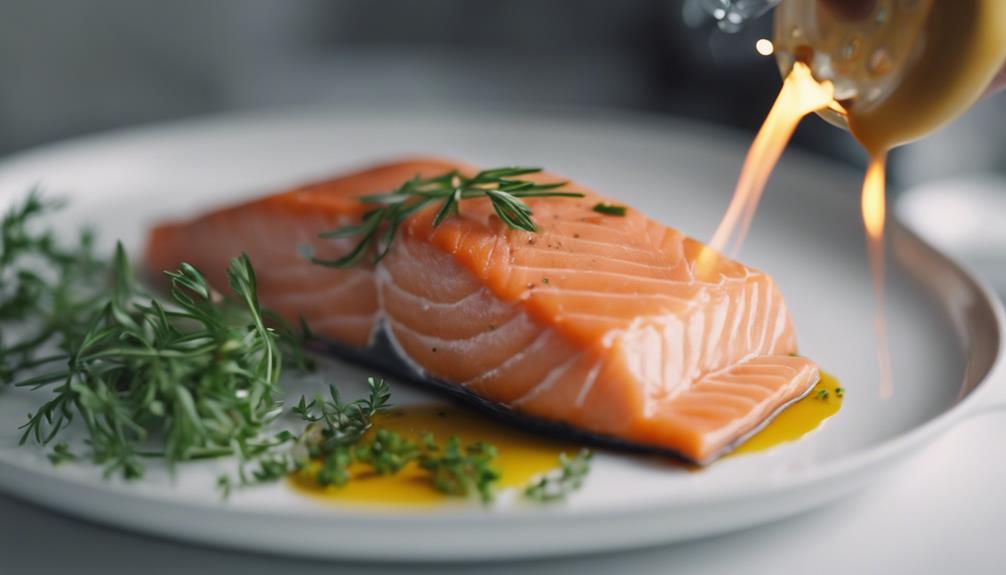
After sous vide cooking your seafood, consider giving it a flavorful crust by searing it to perfection. Searing seafood post sous vide not only adds a delicious outer layer but also enhances the overall texture without risking overcooking.
For an added touch, chilling your seafood in the sous vide pouch in ice water post cooking helps maintain its freshness and texture until you're ready to serve.
Remember, following the recommended cooking temperatures is vital to guarantee your seafood is safe and properly pasteurized. Proper pasteurization is key to both food safety and maintaining the quality of your dish.
Keep in mind to use food-grade bags for sous vide cooking and to avoid cross-contamination at all costs to ensure a safe and enjoyable dining experience for those you're serving.
Sous Vide Seafood Recipe Ideas
Explore a variety of innovative and flavorful sous vide seafood recipes for a culinary experience that highlights the versatility of this cooking technique.
- Sous Vide Lobster Tail: Impress your guests with perfectly cooked lobster tail by sous viding it at 140°F (60°C) for 30 minutes. Enhance the natural sweetness of the lobster by brining it beforehand.
- Sous Vide Salmon with Dill Sauce: Achieve a velvety and tender texture in your salmon by cooking it sous vide at 122°F (50°C) for 40 minutes. Serve it with a rich dill sauce for a delightful combination of flavors.
- Sous Vide Scallops with Lemon Herb Butter: Cook your scallops sous vide at 126°F (52°C) for 30 minutes to achieve a melt-in-your-mouth texture. Finish them off with a drizzle of zesty herb butter for an invigorating twist.
These recipes showcase the precision of sous vide cooking, ensuring your seafood dishes are cooked to perfection every time. Don't forget to pair them with fresh ingredients and handle the seafood with care to deliver delicious results that will leave your guests craving for more.
Frequently Asked Questions
How Do Professional Chefs Use Sous Vide?
You can master sous vide like a pro! Control temperatures precisely, infuse flavors perfectly, and retain moisture for juicy results. Achieve texture perfection, save time, and guarantee consistent dishes. Unleash your culinary creativity with sous vide secrets.
What Is a Disadvantage of Sous Vide?
When using sous vide, a drawback is limited browning for a deep, flavorful crust. Despite this, you'll appreciate the consistent results, precise temperature control, and flavor retention. Plus, it's a time-saving method for busy kitchens!
Can You Overcook Seafood Sous Vide?
You can overcook seafood sous vide if you don't pay attention to proper timing. It's important to control texture, infuse flavor, maintain moisture, and guarantee temperature precision to avoid ruining your dish. Stay vigilant for tender, flavorful results.
What Is the First Thing I Should Sous Vide?
Start with a white, lean fish like cod. Season it well with salt and oil, then sous vide it for taste infusion. Control temperature, follow cooking times, retain texture, and prep your ingredients carefully for a successful first sous vide experience.
Conclusion
Now that you have mastered sous vide seafood cooking techniques, you can enjoy perfectly cooked seafood every time.
Remember to choose the right seafood, prepare it correctly, season it to perfection, cook it at the right temperature and time, and finish it off with your favorite garnishes.
With these tips and recipe ideas, you'll be able to impress your family and friends with restaurant-quality seafood dishes in the comfort of your own home.
Enjoy your culinary adventures with sous vide cooking!
